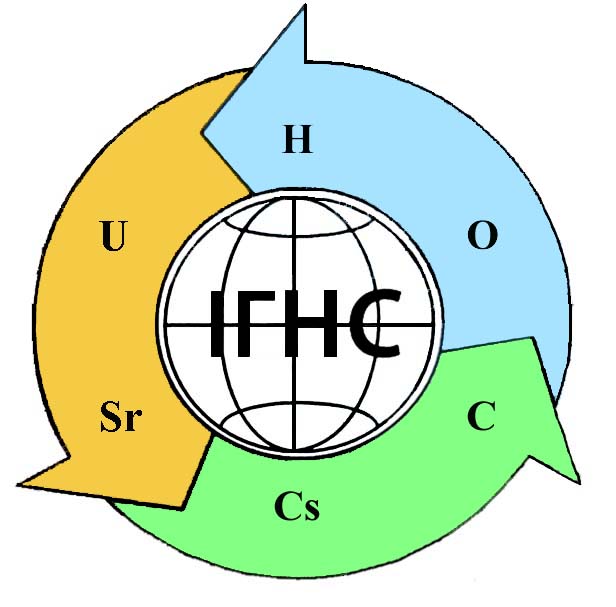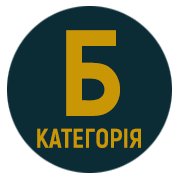USE OF MINERAL PROTON-CONDUCTIVE MEMBRANES FOR ELECTROOSMOTIC FRACTIONATION OF THE HYDROGEN ISOTOPES
DOI:
https://doi.org/10.32782/geotech2022.35.12Keywords:
electroosmosis, fractionation, tritium, hydrogen isotopes, proton-conducting membranesAbstract
The operation of the nuclear fuel complex is constantly accompanied by contamination of liquid industrial discharges with tritium. The problem of preventing such pollution is complicated by the fact that the pollutant component (tritium) is an integral part of the aqueous transport substance. Equally important is the need to purify deuterium water used in the nuclear industry from tritium and to increase the efficiency of tritium concentration technologies for further use. The use of the process of electroosmotic fractionation of hydrogen isotopes is proposed for purification of NPP process waters from tritium. In the isotopic molecule of tritiated or deuterium water ("HTO", "DTO"), the covalent bond D – O and T – O is stronger than H – O, so it is possible to separate the hydrogen isotops by using the electroosmostic method in aqueous solution on composite mineral proton-conducting membranes. Such conductors can provide fractionation of hydrogen isotopes by proton exchange by tunneling or forwarding transport of ions in the process of electroosmosis under the influence of the applied electric field. In order to determine the possibility and efficiency of the electroosmotic process for fractionation of hydrogen isotopes in aqueous solution, we used a three-chamber electroosmotic cell with variable proton-conducting membranes made of mixtures of montmorillonite clay and zeolite (MCZ), montmorillonite and quartz sand (MQS), montmorillonit (MC) and saponite (SC) clays. The anode chambers were filled with electrolyte in the amount of 450–550 cm3, prepared from tritiated water, with a specific activity of 5,950 Bq·dm– 3 with the addition of anhydrous Na2CO3 salt. Under the influence of the electric field, electroosmotic filtration of the dissociated tritiated electrolyte through weakly permeable clay and composite membranes from the anode chamber to the cathode chamber was happening. At the same time, due to the proton conductivity of electroosmotic membranes with increasing strength and voltage of electric current, the alkalinity of the aqueous solution in the cathode chamber increased and the specific activity of tritium in the filtrate (catholyte) decreased by 14–26%. The method is protected by the Patent of Ukraine for a utility model.
References
Bell R. Proton in chemistry. Moscow: Mir, 1977. 384 p.
Erdei-Gruz T. Transport phenomena in aqueous solutions. Moscow: Mir, 1976. 597 p.
Method for obtaining biologically active drinking water with a reduced content of deuterium: Pat. RU 2438765 C1 RF; No. 2010121324/05, Appl. May 25, 2010; publ. 01/10/2012, Bull. No. 1. 7 p.
Method for obtaining biologically active drinking water with a reduced content of deuterium: Pat. RU 2438766 C1 RF; No. 2010121326/05, Appl. May 25, 2010; publ. 01/10/2012, Bull. No. 1. 7 p.
Method for processing raw water containing tritium water: Pat. RU 2648263 C1 RF; No. 2017102757, claim. 01/28/2015; publ. 03/23/2018.
Method for purification of water from tritium by catalytic isotope exchange between water and hydrogen: Pat. RU 2380144 C1 RF; No. 2008117570/15, Appl. May 6, 2008; publ. 27.01.2010, Bull. No. 3. 8 p.
Method for extracting tritium and protium from deuterium-containing water: Pat. RU 2060801 RF; No. 94009122/26, Appl. 03/17/1994; publ. 05/27/1996, Bull. No. 15. 4 p.
Method and installation for the production of light water: Pat. RU 2295493 C2 RF; No. 2004116216/15, Appl. May 28, 2004; publ. 03/20/2007, Bull. No. 8. 16 p.
Double freezer system and water purification method: US Pat. USA 4799945A; No. 07/114 232, Appl. 10/27/1987; publ. 01/24/1989.
Method for the separation of hydrogen isotopes: Pat. RU 2201283 RF; dec. 11/21/2001; publ. 03/27/2003.
Method of water purification and installation for its implementation: Pat RU 2274607 C2 RF; No. 2003104764/15, Appl. 02/17/2003; publ. 20.04.2006, Bull. No. 11. 8 p.
Method and device for water treatment: Pat RU 2400433 C1 RF No. 2009125449/15, Appl. 07/03/2009; publ. 27.09.2010, Bull. No. 27. 6 p.
A method of water purification by freezing it and a device for its implementation: Pat. RU 2142914 C1 RF; dec. 04/24/1998; publ. 12/20/1999.
Method for obtaining healing drinking water with a reduced content of deuterium and tritium "relict water": Pat. RU 2091336 C1 RF; No. 95120754/25, Appl. 12/13/1995; publ. 09/27/1997. 3 s.
The method of obtaining healing drinking water and the installation of VIN-4 "Nadiya" for its implementation: Pat. RU 2010772 C1 RF, No. 5054755/26, Appl. 08/25/1992; publ. 04/15/1994. 7 s.
The method of purification of natural waters and the universal complex block installation "Krizhinka-1" for this purpose: Pat. UA 57558 A Ukraine; No. 20021210638, Appl. 06/16/2003; publ. 06/16/2003, Bull. No. 6.
Andreev B.M., Arefiev D.G., Baranov V.Yu. and others Isotopes: properties, production, applications. T. 1. Under ed.
V.Yu. Baranova. Moscow: Fizmatlit, 2005. 600 p.
Sobotovich E.V., Bondarenko G.N., Vetshtein E.E. et al. Isotope-geochemical methods for assessing the degree of relationship between underground and surface waters. Kyiv: Nauk. Dumka, 1977. 154 p.
Method for processing liquid radioactive waste: Pat. RU 2273066 C1 RF, No. 2004127180/06, Appl. 09/13/2004; publ. 03/27/2006. Bull. No. 9. 8 p.
Pushkarov O., A. Zubko, I. Sevruk, V. Dolin (Jr.) (2021) Electro-osmotic fractionation of hydrogen isotopes in electrolytic solutions using composite proton-permeable membranes. Visnyk of Taras Shevchenko National University of Kyiv: Geology. (2021).
v. 1(92). pp. 11-16. http://doi.org/10.17721/1728-2713.92.02
Pushkarov O.V., Pryjmachenko V.M., Zolkin I.O. (2012). Zbirnyk naukovyh prac. Instytut geohimii navkolyshn'ogo seredovyshha, 20, 98-108.
Pushkarov, O.V, Rudenko, I.M., Koshelev, M.V., SkripkIn, V.V., DolIn, V.V. (Jr.), Pryimachenko, V.M. (2016). Mineral adsorbent of tritium based on sap-onite and zeolite. Collected scientific papers of Institute of environmental ge-ochemistry, 25, 38-48.
The method of separation of heavy hydrogen isotopes: pat. UA 143747 U, No. u 2020 01119, application 21.02.2020; published 10.08.2020, Bul. No. 15. 3 p.









